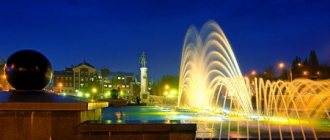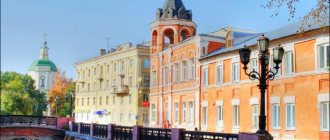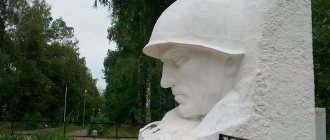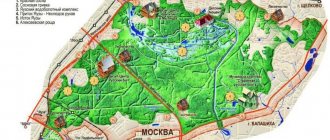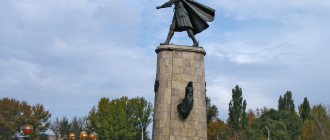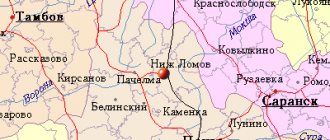CITY OF KOVYLKINO
Kovylkino is a city of republican subordination. Located on the Lashma River. In the “List of populated places of the Penza province” (1869) Voskresenskaya Lashma (Lashma, Kashaevo, Arapovo) is a property village of 92 households in Narovchatsky district. The various names of the settlement indicate the complex path of its development. The settlement was founded by the Mordovians. This is evidenced by its original name lashma “lowland, hollow.” From the “Temnikovsky tenth of V. and G. Kholmogorov” it is clear that in 1703 the Lashma lands were transferred to the baptized Tatar Prince K.N. Kashaev. Since then, Lashma has been called the village of Kashaevo. At the same time, a stone church of the resurrection of Christ was being built in Lashma-Kashayev. With the appearance of the temple, the settlement was called the village of Voskresenskaya Lashma (in contrast to the neighboring Volnaya Lashma and Russian Lashma). Since 1818, Voskresenskaya Lashma came into the possession of Major Nikolai Arapov, whose family ruled here before the Great October Socialist Revolution. In 1892, the Moscow-Kazan railway ran near Voskresenskaya Lashma. The railway station, which received the first train in 1893, was named after the owner of the area - Arapovo. In 1919, the Arapovo station was renamed the Kovylkino station in honor of Stepan Terentyevich Kovylkin, a member of the board of the People's Commissariat of Railways. During the years of Soviet power, a workers' settlement began to rapidly develop around the Kovylkino station, and on November 3, 1960, it was renamed the city of Kovylkzho. Geographical position.
The city of Kovylkino, the center of the municipality, is located in a forest type of landscape in the valley of the river.
Moksha, on the railway line. Territorial aspects of development
In terms of planning, the residential area of the city is divided by the railway into two parts.
There is no single industrial area. The enterprises are located in the southwestern, northwestern and central parts of the city. The building is three-quarters one-story, mostly wooden. In recent years, microdistricts of 2, 3, 5-story capital buildings have begun to emerge in the southwest. The railway, which has access to the western and eastern regions of the country, and the Moksha River are favorable conditions for the development of the city. The expansion of residential areas is planned in the southwestern and northwestern directions. Groundwater resources and water supply.
Groundwater is mainly used for industrial and drinking water supply.
The Middle Carboniferous aquifer is exploited in the region. The predicted operational resources of groundwater for the Kovylkinsky district are 144.7-171.3 thousand m3/day. Modern water intake by large consumers is 6.1 thousand m3/day. The current demand for water for household and drinking needs is 6.3 thousand m3/day, the future one is 8.6 thousand m3/day. Consequently, PERWVs fully satisfy the water needs of the area. The mineralization of extracted water varies from 0.3 to 0.5 g/dm3. According to the chemical composition of the waters, they are hydrocarbonate, chloride-sulfate-hydrocarbonate, chloride-hydrocarbonate-sulfate, calcium-sodium, sodium-calcium, sodium-magnesium. The total hardness is 3.8-14.2 mmol/dm3, the removable hardness is 3.3-6.7 mmol/dm3. The fluorine content is 1.5-3.2 mg/dm3, which determines the need for defluoridation of extracted water. In order to increase the reliability of water supply to the population of the region and the city of Kovylkino, as well as improve water quality, it is planned to: develop the explored reserves of the Kalinovsky site; at the city water intake, carry out measures to protect groundwater (outlining and studying areas of contamination, establishing sanitary protection zones and developing recommendations for the regime of economic activity in this zone); carry out the necessary water treatment at a number of wells. After the Kalinovsky site is put into operation, it is advisable to eliminate the water intakes of industrial enterprises within the city water intake. Surface water resources.
The main source of surface water is the Moksha River. Short-term observations of the hydrological regime were carried out at the site with. Kochelayevo in connection with the construction of a low-pressure dam for irrigation and drainage purposes. The catchment area at the Kovylkino site is 9,762 km2. The river regime under natural conditions differs slightly from the Moksha regime at the Temnikov site. Currently, the river flow is regulated by the Tokmovsky hydroelectric dam built in 1987. A change in the natural regime is manifested in the removal of part of the spring runoff (at the decline of the flood) to fill the bowl of the created reservoir. Its volume at NPU is 2.66 million m3. The annual flow rate of Moksha is Q0 = 33.2 m3/s, volume W0 = 1,047.8 million m3 per year, coefficient of variation Cv = 0.32, ratio of the asymmetry coefficient to the coefficient of variation Cs/Cv = 0.6. The annual distribution of runoff is uneven. In an average year in terms of water content, 79% of its volume occurs in the spring, 14.9% in the summer-autumn period, and 6.1% occurs in the winter. The minimum flow, as in other river sections considered in this work. Moksha, observed in the summer-autumn and winter periods. It should be noted that surface runoff both in the regional center itself and in the region has been almost not used in recent years. The Tokmovskoe reservoir, created for irrigation and drainage purposes, does not fulfill its direct function and is used only as a recreation area.
KOVYLKINO (Voskresenskaya Lashma, Arapovo), city, regional center, before the revolution, Narovchatsky district of the Penza province. The city of Kovylkino (a village until 1960) in the past was the Russian village of Voskresenskaya Lashma, the estate of the Arapov family, who were related to N.N. Pushkina-Lanskaya. Under the Arapovs, a railway passed through the village and a station arose, named after its builder and organizer Arapovo. The station and the village were renamed after the revolution, but who Kovylkin was - there are disagreements that took shape in two versions, which have nothing to do with the spiritual history of the region. In the 19th century, the Resurrection-Lashminsky parish consisted of 3,600 people; currently more than 17,000 people live in the city of Kovylkino.
The first temple, a wooden one, consecrated in honor of the Resurrection of the Lord, was erected by the landowner Gavriil Bektemirovich Kashaev, a Tatar Murza prince who converted to Orthodoxy in 1703 and promised to build a temple in his village of Lashma in honor of this event. In 1704, the church was already ready and consecrated. At the same time, the landowner allocated 10 acres of arable land and hayfields for the benefit of the temple, and then further divided the land for the benefit of the priest. The first priest in Lashma was Afanasy Lazarev. The Resurrection Church existed with alterations until the end of the 18th century. The second church, a stone one, in the name of St. Nicholas, Archbishop of Myra (Nikolskaya), with the Holy Cross chapel, was built by Nikolai Andreevich Arapov in 1791-96 in the classicism style, with one chapter, with a bell tower topped with a spire. In the second half of the 19th century, the Arapov landowners overhauled the temple and commissioned new wall paintings performed by Moscow artists in the academic style. The parish also included the villages of Chernenaya, Andreeva, Slobodenovka, Zapischikovo, and Kurnino. After the revolution, this temple was destroyed, like almost the entire Arapov estate.
In the first years of the existence of the Saransk diocese, in 1993, the construction of a new stone church began in the city, completed in 1995 and consecrated by Bishop (now Metropolitan) of Saransk and Mordovian Barsanuphius in memory of St. Seraphim, the Wonderworker of Sarov. This was the first experience of church building in the diocese, which proved that young parishes are quite capable of such an important task as designing and building the house of God. Not far from the Seraphim Church there is a courtyard of the Insarsky St. Olginsky Monastery with a temple in honor of the Icon of the Mother of God “Tenderness”; Construction of the courtyard of the Kimlyai Alexander Nevsky Monastery began. Another temple was built on the territory of the former Arapov estate - the stone St. Michael the Arkhangelsk.
Source: Archive of the Saransk Diocesan Administration, clergy records for 2000–2008.
Literature: Kholmogorov V. and G. Materials for the history, statistics and archeology of the city of Temnikov and its district XVII–XVIII centuries. – Tambov, 1890, p. 120-122; Churches, clergy and parishes of the Penza diocese. – Penza, 1896, p. 144.
BAKHMUSTOV Sergey Borisovich ORTHODOX PARISH CHURCHES OF MORDOVIA, Dictionary-reference book, 2015.
History of Kovylkin
The year the city was founded is considered to be 1960. But its history goes much further. The oldest settlement on the site of modern Kovylkino is the village. Voskresenskaya Lashma (included within the city of Kovylkino in 1961). It is believed that Lashma was founded by the Mordovians-Moksha in 1237 during the invasion of the Mongol-Tatars (translated from Moksha “lashma” - hollow, valley; the Lashma (Lopatino) river flows here, which flows into Moksha). Subsequently, the settlement became deserted, but was founded again in the second half of the 16th century. Temnikovsky service Tatars. According to the census of 1614, in the village. Novoselki (Lashma) there were 15 households of serving Tatars. In 1703, local lands were given to the Tatar Murza Prince Gabriel Kashaev for his adoption of Orthodoxy, who in 1704 built a church in the name of the Life-Giving Resurrection of Christ. After this, the settlement turned into a village. Resurrection Lashma. In 1790, Voskresenskaya Lashma became the property of the Arapov family. In 1864 s. Voskresenskaya Lashma (Arapovo - Lashma - Kashaevo) of the Narovchatsky district of the Penza province consisted of 92 households with 725 inhabitants. At the end of the 19th century. The estate in Voskresenskaya Lashma belonged to the statesman and public figure, philanthropist Ivan Andreevich Arapov (1844-1913), who was married to Alexandra Petrovna Lanskaya, the daughter of Natalya Nikolaevna Lanskaya-Pushkina. I. A. Arapov turned his estate into a highly profitable diversified enterprise. Thanks to Arapov’s influence, in 1892 the Moscow-Kazan Railway passed near Voskresenskaya Lashma, and the station that appeared here in his honor was named Arapovo. In 1919 Art. Arapovo was renamed Kovylkino - after the name of the party leader, Commissioner of Railways Stepan Terentyevich Kovylkin (1887-1938). Since 1928 Kovylkino is a regional center. In 1940 s. Kovylkino received the status of an urban-type settlement. In 1960, the workers' village of Kovylkino was transformed into a city of regional subordination. Since 1963, Kovylkino has been a city of republican subordination.
Kovylkino station
The Kovylkino railway station (until 1919 – Arapovo station) was opened in 1893.
Coat of arms of Kovylkin
On the coat of arms of the city of Kovylkino, in its central part, there is a circle in which the flags of the Russian Federation and the Republic of Mordovia are enclosed, which symbolizes the unity of peoples, their friendship, and mutual assistance. Next to the circle are located: part of a gear, a construction trowel, and an ear of grain. The gear indicates the importance of mechanical engineering in the area, the trowel indicates that the city is striving for development and its construction is underway, the ear indicates well-developed agriculture (the yellow color of the coat of arms indicates fertile local fields). An azure belt placed at the top of the coat of arms, encircling a circle with flags, symbolizes the river. Moksha (this river flows along Kovylkino, in fact, as if going around it). The railway located at the bottom of the coat of arms is a connection between the history of the city and the name of I. A. Arapov.
Administrative and municipal status[edit]
As part of the administrative divisions, Kovylkino serves as the administrative center of the Kovylkino District, even though it is not part of it. [1] As an administrative division, that is, together with the village in Sosnovy Bor, they are included separately as cities of republican significance in Kovylkino
-an administrative unit with status equal to that of the districts.
[1] As a municipal division, the city of republican significance of Kovylkina is included in the Kovylkino municipal district in the Kovylkino urban settlement
.[4]
Map
| Kovylkino: maps |
Kovylkino: photo from space (Google Maps) Kovylkino: photo from space (Microsoft Virtual Earth)
| Kovylkino. Nearest cities. Distances in km. on the map (in brackets along roads) + direction. Using the hyperlink in the distance , you can get the route (information courtesy of the AutoTransInfo website) | |||
| 1 | Narovchat (Penza region) | 21 (99) | SW |
| 2 | Kadoshkino | 32 (57) | IN |
| 3 | Insar | 34 (38) | SE |
| 4 | Torbeevo | 43 (52) | Z |
| 5 | Krasnoslobodsk | 45 (53) | WITH |
| 6 | Old Shaigovo | 46 () | NE |
| 7 | Atyurievo | 49 (87) | NW |
| 8 | Spassk | 49 (88) | Z |
| 9 | Nizhny Lomov | 57 (64) | YU |
| 10 | Issa (Penza region) | 63 (96) | IN |
| 11 | Elniki | 65 (82) | WITH |
| 12 | Ruzaevka | 67 (73) | IN |
| 13 | Vadinsk (Penza region) | 68 () | SW |
| 14 | Zubova Polyana | 70 (94) | Z |
| 15 | Yalga | 79 () | IN |
| 16 | Temnikov | 80 (100) | NW |
| 17 | Mokshan (Penza region) | 80 (134) | SE |
| 18 | I'll | 81 (135) | NW |
| 19 | Lambir | 82 (113) | IN |
| 20 | Saransk | 84 (99) | IN |
| 21 | Pachelma (Penza region) | 87 (103) | SW |
| 22 | Lukhovka | 87 (107) | IN |
| 23 | Pervomaisk | 92 (114) | WITH |
| 24 | Kamenka | 94 (214) | YU |
| 25 | Pochinki (Nizhny Novgorod region) | 96 (177) | NE |
| 26 | Kochkurovo | 99 (124) | IN |
| 27 | Lunino (Penza region) | 99 (149) | SE |
| 28 | Romodanovo | 102 (126) | NE |
| 29 | Zemetchino (Penza region) | 104 (161) | SW |
| 30 | Grabovo (Penza region) | 104 (177) | SE |
a brief description of
The city is located on the left bank of the river. Moksha (tributary of the Oka), 116 km southwest of Saransk. Railway station.
In the vicinity of Kovylkino there are rest houses and sanatoriums.
Territory (sq. km): 41
Information about the city of Kovylkino on the Russian Wikipedia site
Historical sketch
Originally this is the village of Lashma, which arose no later than the 17th century. (Mordovian lashma “lowland, hollow”). In 1703, it was transferred into the possession of the baptized Tatar prince K.N. Kashaevu and for some time was called Kashaevo. After the construction of the temple in the name of the Resurrection of Christ, it becomes a village and receives the name Resurrection Lashma.
In 1892, a railway passed near the village and a station was opened, named after the landowner Arapovo. The village that arose at the station, which absorbed Voskresenskaya Lashma, was renamed Kovylkino in 1919 after the member of the board of the People's Commissariat of Railways S.T. Kovylkina.
Workers' village of Kovylkino since 1940. City since 1960.
Municipal indicators
| Index | 2001 |
| Demography | |
| Number of births, per 1000 population | 7.6 |
| Number of deaths, per 1000 population | 12.3 |
| Natural increase (decrease), per 1000 population | -4.7 |
| Standard of living of the population and social sphere | |
| Average monthly nominal accrued wages, rub. | 1595 |
| Average housing area per inhabitant (at the end of the year), sq.m. | 23.8 |
| Number of preschool institutions, pcs. | 5 |
| Number of children in preschool institutions, thousand people | 0.7 |
| Number of daytime educational institutions (at the beginning of the school year), pcs. | 6 |
| Number of students in daytime educational institutions, thousand people | 3.1 |
| Number of doctors, people. | 120 |
| Number of nursing staff, people. | 281 |
| Number of hospital institutions, pcs. | 2 |
| Number of hospital beds, thousand units | 0.370 |
| Number of medical outpatient clinics, pcs. | 1 |
| Capacity of medical outpatient clinics, visits per shift, thousand units. | 0.3 |
| Number of registered crimes, pcs. | 858 |
| Persons who committed crimes were identified, persons. | 564 |
| Economy, industry | |
| Number of enterprises and organizations (at the end of the year), pcs. | 251 |
| Construction | |
| Volume of work performed by type of activity “Construction” (until 2004 - volume of work performed under construction contracts), million rubles. | 61.6 |
| Commissioning of residential buildings, thousand sq.m. of total area | 2.3 |
| Commissioning of residential buildings, apartments | 27 |
| Commissioning of preschool institutions, places | 0 |
| Commissioning of educational institutions, places | 0 |
| Commissioning of hospital facilities, beds | 0 |
| Commissioning of outpatient clinics, visits per shift | 0 |
| Transport | |
| Number of bus routes (in intracity traffic), pcs. | 3 |
| Number of passengers transported by buses per year (in intracity traffic), million people. | 0.3 |
| Connection | |
| Number of residential telephone sets of the city public telephone network, thousand units. | 4.8 |
| Trade and services to the population | |
| Retail trade turnover (in actual prices), million rubles. | 320.2 |
| Retail trade turnover (in actual prices), per capita, rub. | 12221 |
| Public catering turnover (in actual prices), million rubles. | 5.7 |
| Volume of paid services to the population (in actual prices), million rubles. | 143.5 |
| Volume of paid services to the population (in actual prices), per capita, rub. | 2906 |
| Volume of household services to the population (in actual prices), million rubles. | 8.7 |
| Volume of household services to the population (in actual prices), per capita, rub. | 332 |
| Investments | |
| Investments in fixed assets (in actual prices), million rubles. | 132.6 |
Data sources:
- Regions of Russia. Main characteristics of the constituent entities of the Russian Federation: statistical collection. Goskomstat of Russia. - M:, 2003.
Economy
(washing machines), "Vegos" (woodworking), "Nadezhda" (oil production), "Elex" (elevator). Distillery, etc.
In the Kovylkino region, rye, barley, wheat, oats, and potatoes are grown. They raise cattle, pigs, and sheep.
Main enterprises
INSTRUMENT ENGINEERING
OJSC "Kovylkinsky Electromechanical Plant"
431300, Republic of Mordovia, Kovylkinsky district, Kovylkino, st.
Proeltarskaya, 27 Offers:
Instruments for measuring electricity
FORESTRY, WOOD PROCESSING AND PULP AND PAPER INDUSTRY
OJSC "Kovylkinsky silicate brick plant"
431308, Republic of Mordovia, Kovylkinsky district, Silikatny village
Offers:
Silicate brick, small wall and partition blocks made of cellular concrete
FOOD INDUSTRY
JSC "Nadezhda" Kovylkinsky Creamery Factory
431300, Republic of Mordovia, Kovylkinsky district, Kovylkino,
Offers:
"Poshekhonsky" cheese, processed cheeses, peasant butter
Culture, science, education
Museum of Local Lore.
12 km from Kovylkino, in the village of Kochelaevo, is the House-Museum of the artist F.V. Sychkova.
Universities of the city
Kovylkino branch of Mordovian State University named after.
N.P. Ogareva 431351, Republic of Mordovia, Kovylkino district, Kovylkino, st. Zhelyabova, 26
Museums, galleries, exhibition halls
House-Museum of F.V. Sychkov 431310, Republic of Mordovia, Kovylkinsky district, village_Kochelaevo Website: https://www.erzia-museum.ru/
Kovylkinsky Museum of Local Lore 431300, Republic of Mordovia, Kovylkinsky district, Kovylkino, st. Bolshevikskaya, 19 Phone(s): (83453) 2-10-89 Website: https://www.mrkm.ru/
Architecture, sights
The city is built up mainly with 5-story buildings.
| Population by year (thousands of inhabitants) | |||||||
| 1939 | 5.1 | 1996 | 23.2 | 2007 | 21.1 | 2015 | 20.6 |
| 1959 | 10.5 | 1998 | 23.2 | 2008 | 20.9 | 2016 | 20.4 |
| 1967 | 15 | 2000 | 23.2 | 2010 | 20.5 | 2017 | 20.1 |
| 1970 | 17.3 | 2001 | 23.1 | 2011 | 21.3 | 2018 | 19.5 |
| 1979 | 20.0 | 2003 | 21.9 | 2012 | 21.1 | 2019 | 19.0 |
| 1989 | 21.6 | 2005 | 21.4 | 2013 | 21.0 | 2020 | 18.9 |
| 1992 | 22.3 | 2006 | 21.2 | 2014 | 20.8 | 2021 | 18.6 |
Kovylkino
(The Republic of Mordovia)
OKATO code:
89410
Founded:
1892
Urban settlement since:
1940
City since:
1960 City of district subordination (Kovylkinsky district of the Republic of Mordovia)
Center:
Kovylkinsky district
Telephone code (reference phone)
| 83453***** | 22-2-92 |
Deviation from Moscow time, hours:
0
Geographic latitude:
54°02′
Geographic longitude:
43°55′
Altitude above sea level, meters:
140 Sunrise and sunset times of the Sun and Moon in the city of Kovylkino
